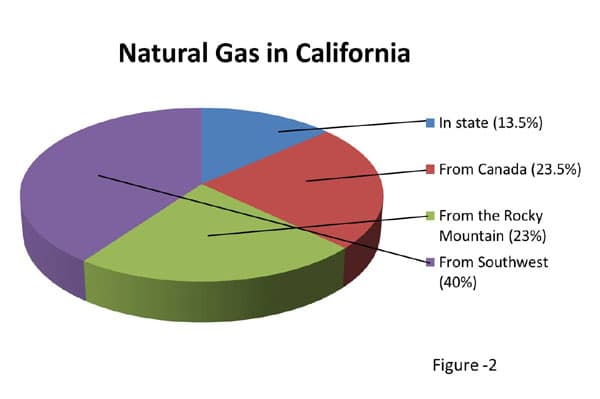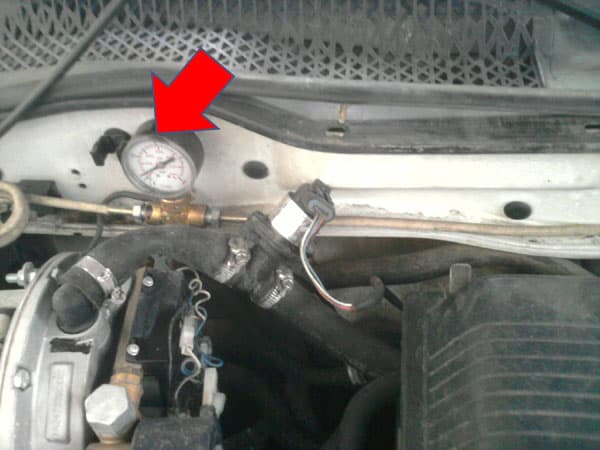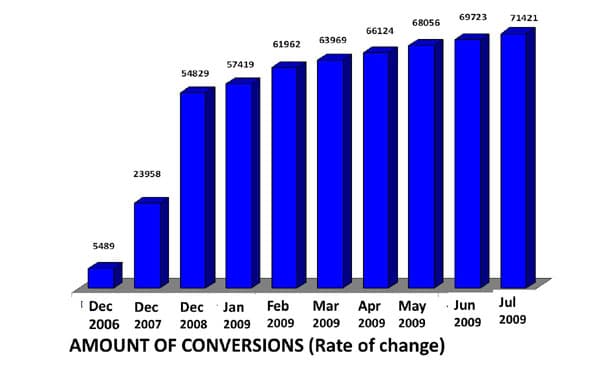3. Background about Natural Gas & the Conversion Process
The political impact and decision-making of agencies, banks and corporations are rapidly changing the approach of conversions of cars in order to let the new era of natural gas start. Attractive loans that are re-paid with the own use of the natural gas are being offered. In other words, the converted cars are loaded with a "smart" microchip that is able to discern if the car is authorized or not to be refilled. Every time that the tank is filled, a portion of the cost paid goes to the loan.
Some of the natural gas companies are owned by the same gasoline companies. Others are new in the business that seems to be very promising.
Central and local governments regulate the conversion process of gasoline motors to natural gas. The laws are now very clear on what to expect. To provide more information, the conversion companies use all the advertising available, but the government has its own informational website too.
A few years ago, the numbers of stations with natural gas were very limited, but in the last 3 years their number has increased rapidly. At the same time the number of conversion shops and the amount of cars converted has increased too. On one side, using natural gas helps the environment with reduced emissions, but on the other hand, the extraction process leaves a bad impression of destruction and pollution of the natural resources. It is this part that has to be evaluated, taking under consideration all pros and cons.
With the rising prices of oil and with several nations at war, a new source of energy is needed. The so called renewable sources are not in a secure list as "renewable" any longer. Similarly, the melting ice due to the global warming, was supposed to stay forever; well, the definition of "forever" I guess has changed.
3.1 Air Pollutants
Several things and our own actions that we are not aware of are causing serious changes in the environment. Using perfumes, drinking bottled water, driving instead of walking / biking, ladies make-up, packaging and transporting foods, cutting trees to construct houses, burning the garbage in a metal cylinder in the backyard, leaving the faucet open when is not needed, longer than needed time in the shower, the abusive use of electricity in a "taken for granted" status, the unnecessary purchase of new clothes when the old ones are still usable, the use of detergent, aromatherapy, the use of pesticides, hormonally active chemicals in our daily diet, genetically engineered products, may explain many illnesses in society. What type of legacy are we going to leave for our future generations? You might focus this paragraph on air pollutants for cohesion.
3.2 Looking for a Solution: Natural Gas Vehicles
After comparing the average emissions rates in the United States between natural gas, oil and coal, a big impression is left that the source that causes the least damage to earth is the use of natural gas. The comparative table presented below shows this analysis. 3

Looking at the above table and asking the question, which of the three combustibles produces fewer emissions, the answer will be obvious. Given the numbers, students can produce a graph-bar or a similar visual tool to explain the amount of emissions per each one. Furthermore, the data is so strong, that the first obvious questions from the audience would be: "Why don't we have more natural gas operated vehicles in the US? However, on the other hand, there is not a presentation of the emissions caused to produce each of the above mentioned combustibles; but at the end, assuming an equitable and well managed extraction processes, the industry of natural gas will continue its growth.
Let's take a look to the consumption of natural gas in California and where it is coming from.
Out of the natural gas used in California, 13.5% is obtained in state, 23.5% from Canada, 23% from the Rocky Mountains and 40% from Southwest. See figure-2

Natural gas Vehicles in Peru
In Peru, the cost of gasoline is approximately $3.00 US in average, while the price of equivalent amount of natural gas is around $0.50 to $1.00 US. These numbers were found during my research in Peru and the comparison of prices is related to the same efficiency per gallon and per mile of usage.
Economically, using natural gas seems as the best alternative with fewer emissions than its counterparts Diesel and gasoline.
GNV is a popular acronym used in Peru for "Gas Natural Vehicular" that means Natural Gas for Vehicles. In US is called "Compressed Natural Gas," (CNG). Several places offer the so called "conversion" of a motor using gasoline to the same motor using GNV. The process of adaptation takes a few hours, adding a tank to hold natural gas and keeping the original tank that uses gas. Therefore, the car could use just gasoline at any time. The experts suggest that the car should start the ignition with gasoline, and after warming up, changing it to GNV with a switch. The newest version has an automatic internal switch that transfers the source of energy from gasoline to natural gas.
Cars with motors have been originally created to use gasoline, and the use of GNV, makes it easy for the motor to deteriorate with the accumulation of residuals from the combustion of the gas. Due to this fact, another suggestion from the experts is that the motor should be checked every 6 months to change the "automatic transferring valve" to continue with the smoothness of the ride. Not doing so implies that the motor will be shutting down continuously, causing a possible deterioration of the starter.
As a positive consequence for our environment, there are fewer contaminants emitted, benefitting air quality. I want to add that after a long time, Lima that had the worst air pollution in South America, given the number of cars using gasoline and diesel, or straight petroleum, has improved its air quality significantly. This is due to the enormous amount of vehicles using GNV.
In the 70's, Peru had vehicles using just gasoline. Many transportation agencies started changing to a new diesel burning engines. In those years, the comparison of prices was 10 soles ($1US) for a gallon of gasoline and only 50 centavos ($0.05US) for a gallon of petroleum. The savings were great but the downside was a negative effect in the environment, not well known in Peru in those days. However, the prevalence of lung diseases increased, and the facades of buildings turned dirty quickly due to the emissions. The houses that had their windows open to receive fresh air, were often seen by their tenants with a lot of black powder on their floors, table clothes, laundry and inclusive their plate of food. Many believed that petroleum was the best fuel choice, misunderstanding the particles and gases emitted. Campaigns from echo friendly agencies induced the government to mandate schools to teach about pollution. Now, after 40 years, the city of Lima has begun a new clean era using GNV. I am personally a witness of these facts.
3.3 The Conversion Process
It was very interesting to see the pipes added to the car I happened to observe for my research in Peru. They were very similar, if not the same, as the ones used in the houses in the USA for the use of gas in the stoves and heaters. The pipes were accompanied by a pressure meter (barometer) that looked like a clock. I have seen this type of barometer in some propane stoves. See figure-3.
The gas companies have rapidly increased the number of stations that offer GNV. They have a sophisticated equipment to measure the pressure of the GNV in the tank, to calculate if it is full or not and to predict how much money would take to fill up the tank.
The government has given all possible facilities to the common individuals to make the changes in their personal vehicles. There are banks currently lending money with very low interest specifically to change to GNV. In addition, to absorb the cost of the conversion, COFIDE (Financial Development Corporation) has created a system where the expensive conversion process is paid with the consumption. In other words, every time the tank is refilled, a portion of the amount paid goes to pay the debt. This is controlled by an electronic device installed in the car and, only authorized stations can refill the tank of an authorized vehicle.

Figure-3
The cost of the change is 4,000 soles (around $1,700US). There are certain makes that offer cars that come from the factory with a motor ready to use GNV, such as Hyundai, Toyota and Nissan. Most universities and technical institutions in Peru are offering GNV instruction in their curriculum, having a new generation of engineers ready to create new versions of GNV cars, with the intention of increasing the efficiency of the use of natural gas. On the other hand, the benefit of the conversions provides a positive outcome to public health. This outcome however is continuously under study.
The number of conversions in Peru since 2006 to 2009 is illustrated in figure-4.
To give an idea of the difference in the amount of emissions between natural gas and gasoline operated vehicles, the US Department of Energy shows on its website the following:
"Natural gas emits approximately 6% to 11% lower levels of GHGs than gasoline
throughout the fuel life cycle." 3a

Figure-4
On the other hand, the EPA has a calculator to find the amount of emissions per mile, per combustible type, which is recommended to access for further information. 3b
GLP is the acronym for "Gas Licuado de Petróleo," that means Petroleum Blended Gas, which is very close to the term "Liquefied." For a while, GLP became very popular, because it was cheaper than gasoline and with fewer emissions than petroleum. It became the substitute of petroleum in Peru. However, although is also gas, there is a process to use regular oil to convert it into GLP. It is this process that creates pollution at a different level, plus the cost of the labor and chemical processors to make the change. Therefore, given that GNV appears in a natural stage, and, because it produces fewer emissions than GLP, it becomes the cleanest combustible to use for cars.
The cost of processing petroleum to convert it to GLP is just half of the cost of processing petroleum to convert it into gasoline. The amount of emissions from GLP is fewer than from gasoline. However, the cost of production of GNV is less than the cost of producing GLP. At the same time, GNV produces fewer emissions than GLP. Comparing these facts, it is obvious that there is a big tendency to change from gasoline, petroleum or GLP to GNV. As a matter of fact, the car that I observed for my research, initially had been converted from gasoline to GLP, but it was at the shop, in the process to be converted to GNV. The conversion process took a few hours and at the end, it was suggested to leave the car for two to three days in the shop for further tests. After this period of time, it was recommended to ride the car smoothly for a few more days. Another suggestion was to let it warm up a few minutes to allow the automatic change from gasoline to GNV. Rewrite this paragraph for greater clarity; I'm not sure what you mean.

Comments: